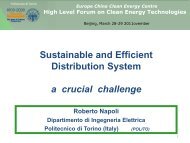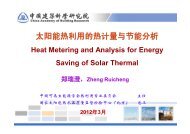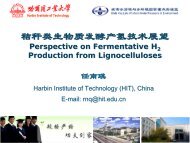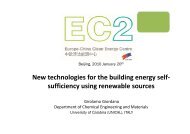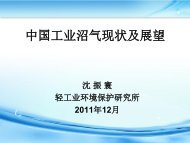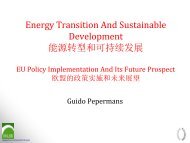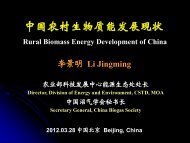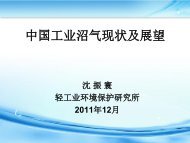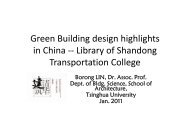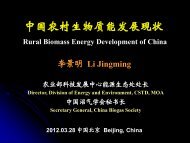Luciano Rolando-EU RDD on New Energy and Energy Saving ...
Luciano Rolando-EU RDD on New Energy and Energy Saving ...
Luciano Rolando-EU RDD on New Energy and Energy Saving ...
You also want an ePaper? Increase the reach of your titles
YUMPU automatically turns print PDFs into web optimized ePapers that Google loves.
POLITECNICO DI TORINO - ENERGY DEPARTMENT<br />
<str<strong>on</strong>g>EU</str<strong>on</strong>g> RD/D <strong>on</strong> <strong>New</strong> <strong>Energy</strong> & <strong>Energy</strong> <strong>Saving</strong> Vehicles<br />
<strong>and</strong> <str<strong>on</strong>g>EU</str<strong>on</strong>g>-China Cooperati<strong>on</strong><br />
Two Examples of hybrid urban busses design for the city of Turin<br />
Federico Millo<br />
<str<strong>on</strong>g>Luciano</str<strong>on</strong>g> <str<strong>on</strong>g>Rol<strong>and</strong>o</str<strong>on</strong>g><br />
Workshop <strong>on</strong> Electric Buses <strong>and</strong> Taxis<br />
April 27, 2012 – Beijing<br />
Speaker<br />
<str<strong>on</strong>g>Luciano</str<strong>on</strong>g> <str<strong>on</strong>g>Rol<strong>and</strong>o</str<strong>on</strong>g>
POLITECNICO DI TORINO - ENERGY DEPARTMENT<br />
Summary<br />
1. Stop & Start Assessment <strong>on</strong> Urban Buses:<br />
• Introducti<strong>on</strong>: a brief introducti<strong>on</strong> <strong>on</strong> the S&S systems<br />
• Case Study: descripti<strong>on</strong> of the system taken into account<br />
• Results: main findings of the projects <strong>on</strong> both regulatory driving cycles <strong>and</strong> real world driving<br />
c<strong>on</strong>diti<strong>on</strong>s<br />
• C<strong>on</strong>clusi<strong>on</strong>s<br />
2. HYBUS: The <strong>New</strong> Eco-friendly Hybrid Bus<br />
27/04/2012<br />
• Motivati<strong>on</strong>s<br />
• The prototype: descripti<strong>on</strong> of the main features of the vehicle.<br />
• The Modular layout: overview <strong>on</strong> the layout of the revamped vehicle<br />
• Awards<br />
2
POLITECNICO DI TORINO - ENERGY DEPARTMENT<br />
Summary<br />
1. Stop & Start Assessment <strong>on</strong> Urban Buses:<br />
• Introducti<strong>on</strong>: a brief introducti<strong>on</strong> <strong>on</strong> the S&S systems<br />
• Case Study: descripti<strong>on</strong> of the system taken into account<br />
• Results: main findings of the projects <strong>on</strong> both regulatory driving cycles <strong>and</strong> real world driving<br />
c<strong>on</strong>diti<strong>on</strong>s<br />
• C<strong>on</strong>clusi<strong>on</strong>s<br />
2. HYBUS: The <strong>New</strong> Eco-friendly Hybrid Bus<br />
27/04/2012<br />
• Motivati<strong>on</strong>s<br />
• The prototype: descripti<strong>on</strong> of the main features of the vehicle.<br />
• The Modular layout: overview <strong>on</strong> the layout of the revamped vehicle<br />
• Awards<br />
3
POLITECNICO DI TORINO - ENERGY DEPARTMENT<br />
STOP & START ASSESSMENT ON URBAN BUSES:<br />
THE GTT – IRISBUS CASE<br />
The aim of this research activity is the assessment of the potentiality of a urban<br />
bus equipped with a Start & Stop (S&S) system in real world driving c<strong>on</strong>diti<strong>on</strong>s<br />
through the analysis of the data collected from a circulating test fleet.<br />
4
POLITECNICO DI TORINO - ENERGY DEPARTMENT<br />
Summary<br />
1. Stop & Start Assessment <strong>on</strong> Urban Buses:<br />
• Introducti<strong>on</strong>: a brief introducti<strong>on</strong> <strong>on</strong> the S&S systems<br />
• Case Study: descripti<strong>on</strong> of the system taken into account<br />
• Results: main findings of the projects <strong>on</strong> both regulatory driving cycles <strong>and</strong> real world driving<br />
c<strong>on</strong>diti<strong>on</strong>s<br />
• C<strong>on</strong>clusi<strong>on</strong>s<br />
2. HYBUS: The <strong>New</strong> Eco-friendly Hybrid Bus<br />
27/04/2012<br />
• Motivati<strong>on</strong>s<br />
• The prototype: descripti<strong>on</strong> of the main features of the vehicle.<br />
• The Modular layout: overview <strong>on</strong> the layout of the revamped vehicle<br />
• Awards<br />
5
Hybrid Vehicles<br />
Benefits:<br />
ENGINE<br />
BATTERY<br />
BATTERY<br />
• Available technology (but not “off-the-shelf”) .<br />
14/11/2011<br />
• Requires several vehicle updates but not radical changes .<br />
POLITECNICO DI TORINO - ENERGY DEPARTMENT<br />
• 3% - 4% Composite FE benefit (NEDC cycle), substantially bigger FE (8-9%) in city drives.<br />
• Favorable cost/benefit ratio.<br />
Start & Stop System – Introducti<strong>on</strong><br />
ELECTRIC<br />
MOTOR<br />
ENGINE<br />
ELECTRIC<br />
MOTOR<br />
Micro Hybrid<br />
Mild Hybrid<br />
Full Hybrid<br />
Battery<br />
Vehicle<br />
Series<br />
Hybrid<br />
Start & Stop System<br />
• The automatic stop of the engine during<br />
normal idle, when the vehicle is stati<strong>on</strong>ary.<br />
• The automatic start of the engine in resp<strong>on</strong>se<br />
to driver or other inputs, usually determined by<br />
clutch acti<strong>on</strong>, brake release.<br />
6
FEATURES:<br />
• N<strong>on</strong>-intrusive Micro-Hybrid system<br />
POLITECNICO DI TORINO - ENERGY DEPARTMENT<br />
Start & Stop System – Introducti<strong>on</strong><br />
To implement a S&S system there are two possibilities:<br />
Enhanced Starter Belt Alternator Starter<br />
• St<strong>and</strong>ard starter with enhanced performance & durability.<br />
• No power electr<strong>on</strong>ic required (low cost).<br />
• Reduced noise <strong>and</strong> start time (compared to key cranking).<br />
• Minimal integrati<strong>on</strong> impact.<br />
• 12V c<strong>on</strong>v. electrical system<br />
• w/ add. buffer battery or DC/DC c<strong>on</strong>verter<br />
27/04/2012<br />
FEATURES:<br />
• N<strong>on</strong>-intrusive Micro-Hybrid system<br />
• Use 2kW (approx) motor-generator unit (MGU) in place of<br />
alternator<br />
• Power electr<strong>on</strong>ics c<strong>on</strong>trol the MGU<br />
• Quiet <strong>and</strong> fast cranking<br />
• Requires adaptati<strong>on</strong> of belt accessory drive (new tensi<strong>on</strong>er<br />
system)<br />
• C<strong>on</strong>venti<strong>on</strong>al starter motor for cold cranking, system<br />
safety<br />
• It can also enable regenerative braking<br />
7
POLITECNICO DI TORINO - ENERGY DEPARTMENT<br />
Start & Stop System – Introducti<strong>on</strong><br />
Despite of its simplicity, a Start & Stop system introduces several issues in the vehicle design:<br />
27/04/2012<br />
8
14/11/2011 8. ...<br />
POLITECNICO DI TORINO - ENERGY DEPARTMENT<br />
Start & Stop System – Introducti<strong>on</strong><br />
Nowadays S&S systems represent an established soluti<strong>on</strong> from passenger cars.<br />
On the other h<strong>and</strong>, urban buses represent a more challenging applicati<strong>on</strong> since they introduce additi<strong>on</strong>al issues<br />
that have to be taken into account in the design process:<br />
1. L<strong>on</strong>ger time spent in idle (about 26% for passenger cars vs. 45% for busses).<br />
2. Higher number of stops (3.85 num/km).<br />
3. More severe requirements of the engine cranking phase (higher fricti<strong>on</strong>s).<br />
4. Higher electrical loads (critical for the battery).<br />
5. Higher NVH issues.<br />
6. Feelings of the drivers.<br />
From City-cars To Supercars<br />
7. Effects <strong>on</strong> the vehicle reliability.<br />
9
POLITECNICO DI TORINO - ENERGY DEPARTMENT<br />
Summary<br />
1. Stop & Start Assessment <strong>on</strong> Urban Buses:<br />
• Introducti<strong>on</strong>: a brief introducti<strong>on</strong> <strong>on</strong> the S&S systems<br />
• Case Study: descripti<strong>on</strong> of the system taken into account<br />
• Results: main findings of the projects <strong>on</strong> both regulatory driving cycles <strong>and</strong> real world driving<br />
c<strong>on</strong>diti<strong>on</strong>s<br />
• C<strong>on</strong>clusi<strong>on</strong>s<br />
2. HYBUS: The <strong>New</strong> Eco-friendly Hybrid Bus<br />
27/04/2012<br />
• Motivati<strong>on</strong>s<br />
• The prototype: descripti<strong>on</strong> of the main features of the vehicle.<br />
• The Modular layout: overview <strong>on</strong> the layout of the revamped vehicle<br />
• Awards<br />
10
Engine start & stop functi<strong>on</strong>s are managed by<br />
the Multiplex.<br />
POLITECNICO DI TORINO - ENERGY DEPARTMENT<br />
Case study: Citelis Irisbus<br />
The bus c<strong>on</strong>sidered in this study features a S&S system based <strong>on</strong> an enhanced starter (no regenerative braking)<br />
Citelis Irisbus:<br />
• Dimensi<strong>on</strong>s: 18 m<br />
• Doors: 3 o 4<br />
• Applicati<strong>on</strong>: urban / suburban<br />
• Test Fleet: 2 Diesel <strong>and</strong> 2 CNG<br />
Vehicles<br />
Engine: IVECO Cursor 8<br />
• Displacement: 7.8 liter<br />
• Fuel: Diesel/CNG<br />
• Power: CNG 243 kW Diesel: 280<br />
kW<br />
Battery integrated by Supercapacitors:<br />
• 22 units<br />
• <strong>Energy</strong>: 120 kJ<br />
• Voltage: 52V<br />
• Charge Current : 100A<br />
• Discharge Limit: 500A<br />
Battery Packs (120 Ah)<br />
Supercapacitor<br />
11
Implemented C<strong>on</strong>trol Strategy:<br />
S&S Enabled:<br />
Stop C<strong>on</strong>diti<strong>on</strong>s<br />
Restart C<strong>on</strong>diti<strong>on</strong>s:<br />
27/04/2012<br />
POLITECNICO DI TORINO - ENERGY DEPARTMENT<br />
Case study: Citelis Irisbus<br />
- Switch S&S mode ON<br />
- Coolant temperature > 45°C<br />
- Driver <strong>on</strong> his driver seat<br />
- Gearbox not in Rear gear positi<strong>on</strong><br />
- Vehicle speed > 5km/h during the previous run.<br />
- Vehicle speed < 3km/h; Air pressure for servosytems > 9 Bars<br />
- Supercaps energy > 65 KJ ( in order to save the energy of the main battery during the<br />
start )<br />
- Driver present <strong>on</strong> his seat<br />
- No acti<strong>on</strong> <strong>on</strong> the inhibiti<strong>on</strong> pedal<br />
There is no c<strong>on</strong>diti<strong>on</strong> to restart. Any acti<strong>on</strong> <strong>on</strong> the accelerator pedal will<br />
launch the restart of the engine<br />
If the energy stored in the supercap drops below 65 kJ the engine is<br />
automatically restarted<br />
12
Remote M<strong>on</strong>itoring System: INTELLIBUS:<br />
POLITECNICO DI TORINO - ENERGY DEPARTMENT<br />
Each vehicle is equipped with a remote m<strong>on</strong>itoring system that through a GMS SIM card allows the recording of<br />
the main trip data.<br />
27/04/2012<br />
Case study: Citelis Irisbus<br />
The aim of this functi<strong>on</strong> is to get informati<strong>on</strong> from the vehicles <strong>and</strong><br />
especially from the Stop&Start use, during the test drives.<br />
The Intellibus system with its dedicated fleetweb applicati<strong>on</strong> from<br />
Digigroup was used.<br />
This soluti<strong>on</strong> is able to deliver through a dedicated website, to all<br />
authorized users, real time or daily reports.<br />
In additi<strong>on</strong> to the usual service m<strong>on</strong>itoring developed by the Intellibus<br />
for the Citelis, additi<strong>on</strong>al features c<strong>on</strong>cerning the S&S functi<strong>on</strong> have<br />
been added.<br />
13
Remote M<strong>on</strong>itoring System: INTELLIBUS:<br />
POLITECNICO DI TORINO - ENERGY DEPARTMENT<br />
Case study: Citelis Irisbus<br />
Available Informati<strong>on</strong><br />
Data Analysis<br />
Trip Map – Event<br />
Representati<strong>on</strong><br />
14
POLITECNICO DI TORINO - ENERGY DEPARTMENT<br />
Summary<br />
1. Stop & Start Assessment <strong>on</strong> Urban Buses:<br />
• Introducti<strong>on</strong>: a brief introducti<strong>on</strong> <strong>on</strong> the S&S systems<br />
• Case Study: descripti<strong>on</strong> of the system taken into account<br />
• Results: main findings of the projects <strong>on</strong> both regulatory driving cycles <strong>and</strong> real world driving<br />
c<strong>on</strong>diti<strong>on</strong>s<br />
• C<strong>on</strong>clusi<strong>on</strong>s<br />
2. HYBUS: The <strong>New</strong> Eco-friendly Hybrid Bus<br />
27/04/2012<br />
• Motivati<strong>on</strong>s<br />
• The prototype: descripti<strong>on</strong> of the main features of the vehicle.<br />
• The Modular layout: overview <strong>on</strong> the layout of the revamped vehicle<br />
• Awards<br />
15
POLITECNICO DI TORINO - ENERGY DEPARTMENT<br />
The first analysis <strong>on</strong> the tested vehicle was performed <strong>on</strong> a regulatory driving cycle suitable for urban<br />
busses applicati<strong>on</strong>s:<br />
Experimental Setup:<br />
Cycle SORT is a st<strong>and</strong>ardize <strong>and</strong> modular driving cycle for fuel c<strong>on</strong>sumpti<strong>on</strong> calculati<strong>on</strong><br />
• Vehicle: Citelis CNG Bus<br />
Results: data from SORT Cycle<br />
SORT1 SORT2<br />
Average Speed: 12 km/h Average Speed: 18 km/h<br />
• Vehicle mass: 23725 kg (vehicle + 1 passenger of 65 kg).<br />
• The simulati<strong>on</strong>s were performed at FIAT test circuit (Balocco).<br />
• The idle fuel c<strong>on</strong>sumpti<strong>on</strong> is measured through a dedicated measurement system to achieve higher<br />
accuracy.<br />
16
120%<br />
100%<br />
80%<br />
60%<br />
40%<br />
20%<br />
0%<br />
100% 100%<br />
90%<br />
SORT1<br />
Supercap Supercap<br />
En. Before En. A0er<br />
98,0kJ 98,0kJ<br />
96,0kJ 97,0kJ<br />
98,0kJ 97,0kJ<br />
97,0kJ 97,0kJ<br />
POLITECNICO DI TORINO - ENERGY DEPARTMENT<br />
Results: data from SORT Cycle<br />
Fuel C<strong>on</strong>sumpA<strong>on</strong> ReducA<strong>on</strong><br />
SORT1 SORT2<br />
94%<br />
SORT2<br />
Supercap Supercap<br />
En. Before En. A0er<br />
83,0kJ 100,0kJ<br />
85,0kJ 101,0kJ<br />
100,0kJ 102,0kJ<br />
101,0kJ 100,0kJ<br />
C<strong>on</strong>ven2<strong>on</strong>al<br />
S&S<br />
• The S&S System shows<br />
significant reducti<strong>on</strong> of<br />
the fuel c<strong>on</strong>sumpti<strong>on</strong><br />
• SORT1 has greater<br />
reducti<strong>on</strong> due to the<br />
l<strong>on</strong>ger idle time.<br />
The use of the S&S system<br />
does not affect the energy<br />
stored in the supercap.<br />
17
POLITECNICO DI TORINO - ENERGY DEPARTMENT<br />
Results: data from circulating test fleet<br />
All the tested vehicle travel the same route from Turin downtown <strong>and</strong> to the suburbs.<br />
Length of the route: about 14 km<br />
27/04/2012<br />
Turin Downtown<br />
San Mauro Torinese<br />
Average: 204 km<br />
• A time horiz<strong>on</strong> of about two weeks was c<strong>on</strong>sidered as reference interval to enable or<br />
disable the S&S system.<br />
• This choice allows testing the system <strong>on</strong> the same boundary c<strong>on</strong>diti<strong>on</strong>s (traffic, weather)<br />
• For sake of brevity in this presentati<strong>on</strong> <strong>on</strong>ly the results of Diesel vehicles will be presented.<br />
• Data from November 2011 to March 2012 will be c<strong>on</strong>sidered<br />
Average: 3.69 num/km<br />
18
POLITECNICO DI TORINO - ENERGY DEPARTMENT<br />
Results: data from circulating test fleet<br />
Focusing <strong>on</strong> a shorter time-horiz<strong>on</strong> it is possible to highlight the features of the S&S system<br />
When the S&S is enabled, the number of vehicle stops with the<br />
engine off is quite close to the total number<br />
Number of Events / km<br />
Average Stops 3,71<br />
Average S&S events 3,05<br />
A significant number of S&S events is inhibited by the driver while<br />
there are no inhibiti<strong>on</strong>s related to low energy stored in the<br />
supercapacitors.<br />
S&S disabled: about 38% of<br />
the time spent in idle<br />
S&S enabled: about 27% of<br />
the time spent in idle<br />
C<strong>on</strong>sequently also a reducti<strong>on</strong> of the fuel c<strong>on</strong>sumpti<strong>on</strong> in<br />
idle c<strong>on</strong>diti<strong>on</strong> can be observed 19
POLITECNICO DI TORINO - ENERGY DEPARTMENT<br />
Results: data from circulating test fleet<br />
Globally the comparis<strong>on</strong> of the vehicle fuel c<strong>on</strong>sumpti<strong>on</strong> points out that the S&S system achieves a reducti<strong>on</strong> of<br />
about 7% in real world driving c<strong>on</strong>diti<strong>on</strong>s<br />
27/04/2012<br />
20
14/11/2011<br />
POLITECNICO DI TORINO - ENERGY DEPARTMENT<br />
Results: data from circulating test fleet<br />
This study also included a dedicated maintenance program to m<strong>on</strong>itor any effects of the S&S system <strong>on</strong> the<br />
comp<strong>on</strong>ents of the driveline<br />
The starter was found to be the killer comp<strong>on</strong>ent: it represents the main cause of vehicle failure related to the S&S system<br />
Vehicle 791 792 1310<br />
Starter Maintenance Date date 27/05/11 23/03/11 31/03/11<br />
Actuati<strong>on</strong>s num 44’730 32’494 38’357<br />
Working hours h 2012.1 1377.1 1679<br />
Travelled Distance km 32’979 20’150 26’056<br />
Actuati<strong>on</strong>s since last maintenance num 23’967 //// ////<br />
Nevertheless the failure of the starter always occurred very close to the nominal life set by the manufacturer (40000 actuati<strong>on</strong>s)<br />
<strong>New</strong> Starter Failed Starter<br />
• The brush wear was the main<br />
cause of the starter failure.<br />
• This phenomen<strong>on</strong> produced<br />
sparks <strong>and</strong> an overheating of<br />
the system which significantly<br />
damaged also the collector of the<br />
rotor.<br />
21
POLITECNICO DI TORINO - ENERGY DEPARTMENT<br />
Summary<br />
1. Stop & Start Assessment <strong>on</strong> Urban Buses:<br />
• Introducti<strong>on</strong>: a brief introducti<strong>on</strong> <strong>on</strong> the S&S system<br />
• Case Study: descripti<strong>on</strong> of the system taken into account<br />
• Results: main findings of the projects <strong>on</strong> both regulatory driving cycles <strong>and</strong> real world driving<br />
c<strong>on</strong>diti<strong>on</strong>s<br />
• C<strong>on</strong>clusi<strong>on</strong>s<br />
2. HYBUS: The <strong>New</strong> Eco-friendly Hybrid Bus<br />
27/04/2012<br />
• Motivati<strong>on</strong>s<br />
• The prototype: descripti<strong>on</strong> of the main features of the vehicle.<br />
• The Modular layout: overview <strong>on</strong> the layout of the revamped vehicle<br />
• Awards<br />
22
POLITECNICO DI TORINO - ENERGY DEPARTMENT<br />
• Up to 77’000 km/vehicle (250’000 km total) travelled by the test fleet vehicles without any<br />
major failure of the system.<br />
• The data collected from the circulating fleet highlighted a lower usage of the vehicles when<br />
the S&S is enabled.<br />
• 7% average fuel c<strong>on</strong>sumpti<strong>on</strong> savings <strong>on</strong> urban trips during 5 m<strong>on</strong>ths m<strong>on</strong>itoring<br />
• S&S system almost never inhibited due to supercapacitors low energy<br />
• Two weeks seems to be a reas<strong>on</strong>able time-horiz<strong>on</strong> to disable <strong>and</strong>/or enable the S&S<br />
system. Therefore the performance of the system can be tested <strong>on</strong> the same vehicle <strong>and</strong><br />
<strong>on</strong> the same trip.<br />
• The analysis of the broken starter shows that main cause of failure is the wear of the<br />
brushes which produced sparks <strong>and</strong> an overheating of the comp<strong>on</strong>ents.<br />
27/04/2012<br />
C<strong>on</strong>clusi<strong>on</strong>s<br />
23
POLITECNICO DI TORINO - ENERGY DEPARTMENT<br />
Summary<br />
1. Stop & Start Assessment <strong>on</strong> Urban Buses:<br />
• Introducti<strong>on</strong>: a brief introducti<strong>on</strong> <strong>on</strong> the S&S system<br />
• Case Study: descripti<strong>on</strong> of the system taken into account<br />
• Results: main findings of the projects <strong>on</strong> both regulatory driving cycles <strong>and</strong> real world driving<br />
c<strong>on</strong>diti<strong>on</strong>s<br />
• C<strong>on</strong>clusi<strong>on</strong>s<br />
2. HYBUS: The <strong>New</strong> Eco-friendly Hybrid Bus<br />
27/04/2012<br />
• Motivati<strong>on</strong>s<br />
• The prototype: descripti<strong>on</strong> of the main features of the vehicle.<br />
• The Modular layout: overview <strong>on</strong> the layout of the revamped vehicle<br />
• Awards<br />
24
POLITECNICO DI TORINO - ENERGY DEPARTMENT<br />
HYBUS<br />
The <strong>New</strong> Eco-friendly Hybrid Bus<br />
The main targets of Hybus, the new eco-friendly bus developed in the framework of the AMPERE project, are<br />
• The study of a modular hybrid propulsi<strong>on</strong> system suitable for urban busses.<br />
• The c<strong>on</strong>versi<strong>on</strong> of vehicles currently equipped with Euro 0–1–2 engines into buses with serial hybrid power<br />
packs.<br />
• The evaluati<strong>on</strong> in real world driving c<strong>on</strong>diti<strong>on</strong>s of the performance of the proposed hybrid architecture
POLITECNICO DI TORINO - ENERGY DEPARTMENT<br />
Summary<br />
1. Stop & Start Assessment <strong>on</strong> Urban Buses:<br />
• Introducti<strong>on</strong>: a brief introducti<strong>on</strong> <strong>on</strong> the S&S system<br />
• Case Study: descripti<strong>on</strong> of the system taken into account<br />
• Results: main findings of the projects <strong>on</strong> both regulatory driving cycles <strong>and</strong> real world driving<br />
c<strong>on</strong>diti<strong>on</strong>s<br />
• C<strong>on</strong>clusi<strong>on</strong>s<br />
2. HYBUS: The <strong>New</strong> Eco-friendly Hybrid Bus<br />
27/04/2012<br />
• Motivati<strong>on</strong>s<br />
• The prototype: descripti<strong>on</strong> of the main features of the vehicle.<br />
• The Modular layout: overview <strong>on</strong> the layout of the revamped vehicle<br />
• Awards<br />
26
1. Electrificati<strong>on</strong> of the powertrain:<br />
POLITECNICO DI TORINO - ENERGY DEPARTMENT<br />
Motivati<strong>on</strong>s<br />
• Series hybrid architecture was found to be the most suitable for this kind of applicati<strong>on</strong>s since it can be easily adapted to the<br />
chassis layout <strong>and</strong> allows to optimize the interiors of the vehicle.<br />
• Moreover, since the driving schedule of a urban bus is usually well-known, the energy management system of the vehicle can be<br />
design to minimize the use of the internal combusti<strong>on</strong> engine <strong>and</strong> exploit the c<strong>on</strong>necti<strong>on</strong> to the grid to recharge the battery at the<br />
end of the missi<strong>on</strong>.<br />
2. Revamping:<br />
• The c<strong>on</strong>versi<strong>on</strong> of an old c<strong>on</strong>venti<strong>on</strong>al vehicle equipped with an internal combusti<strong>on</strong> engine to a hybrid vehicle has the following<br />
advantages:<br />
1. it reduces polluti<strong>on</strong> in our cities, <strong>and</strong> makes it possible to cut costs <strong>and</strong> capital spending.<br />
2. The revamping offers a saving of approximately:<br />
• 45% in comparis<strong>on</strong> with a new Diesel Bus<br />
• 50% in comparis<strong>on</strong> with a new CNG Bus<br />
• 60% in comparis<strong>on</strong> with a new hybrid Bus<br />
3. The revamping process also helps to solve the problems related to the eliminati<strong>on</strong> of obsolete vehicles.<br />
4. Possibility to exploit public fund for low emissi<strong>on</strong> vehicles.<br />
5. The road tests in a typical urban cycle has c<strong>on</strong>firmed an FE reduced of 40% respect to a new Diesel Bus<br />
27
POLITECNICO DI TORINO - ENERGY DEPARTMENT<br />
Summary<br />
1. Stop & Start Assessment <strong>on</strong> Urban Buses:<br />
• Introducti<strong>on</strong>: a brief introducti<strong>on</strong> <strong>on</strong> the S&S system<br />
• Case Study: descripti<strong>on</strong> of the system taken into account<br />
• Results: main findings of the projects <strong>on</strong> both regulatory driving cycles <strong>and</strong> real world driving<br />
c<strong>on</strong>diti<strong>on</strong>s<br />
• C<strong>on</strong>clusi<strong>on</strong>s<br />
2. HYBUS: The <strong>New</strong> Eco-friendly Hybrid Bus<br />
27/04/2012<br />
• Motivati<strong>on</strong>s<br />
• The prototype: descripti<strong>on</strong> of the main features of the vehicle.<br />
• The Modular layout: overview <strong>on</strong> the layout of the revamped vehicle<br />
• Awards<br />
28
• Max Speed: 65 Km/h<br />
• Max Grade = 14 %, up to 15 km/h<br />
• Pure electric drive range = 40 km<br />
• Vehicle Mass (St<strong>and</strong>ard A): 11.200 Kg<br />
• Vehicle Mass (St<strong>and</strong>ard F) 18.400 Kg<br />
POLITECNICO DI TORINO - ENERGY DEPARTMENT<br />
HYBUS: the prototype<br />
Performance of the vehicle:<br />
• Min accelerati<strong>on</strong>: 1,1 m/s 2 29
Series Hybrid Powertrain:<br />
• The old internal combusti<strong>on</strong><br />
engine will be updated with an<br />
Auxiliary Power Unit based <strong>on</strong><br />
a <str<strong>on</strong>g>EU</str<strong>on</strong>g>RO5 –Diesel engine<br />
• The gearbox will be substituted<br />
with a electric powertrain made<br />
up of two electric motors<br />
• Installati<strong>on</strong> of a Li-i<strong>on</strong> battery<br />
<strong>and</strong> relative BMS<br />
• Electrificati<strong>on</strong> of the main<br />
accessories<br />
• Integrati<strong>on</strong> of the new<br />
powertrain <strong>and</strong> of the old<br />
electric systems<br />
POLITECNICO DI TORINO - ENERGY DEPARTMENT<br />
HYBUS: the old vehicle<br />
A old IVECO 490 <str<strong>on</strong>g>EU</str<strong>on</strong>g>RO1 of 1994 represents the vehicle to be restored<br />
• Restyle of the interiors.<br />
• The weight of the vehicle.<br />
• The brakes <strong>and</strong> the steering system.<br />
27/04/2012<br />
Interiors<br />
• Change of the rear structure to install the battery.<br />
• Installati<strong>on</strong> of the new electr<strong>on</strong>ic systems.<br />
These updates will keep unchanged:<br />
Body<br />
• Restyle of the main<br />
comp<strong>on</strong>ents of the<br />
body <strong>and</strong> change of<br />
colors.<br />
30
The main system accessories are<br />
electrified in order to achieve high<br />
efficiency.<br />
Battery pack: it is made up of 4<br />
st<strong>and</strong>ard modules series<br />
c<strong>on</strong>nected, corresp<strong>on</strong>ding to a<br />
total energy of 100kWh <strong>and</strong><br />
150kW (max).<br />
The Auxiliary Power Unit<br />
c<strong>on</strong>sists of a 1.3 liter Diesel<br />
engine (66 kW) c<strong>on</strong>nected to a PM<br />
electric generator.<br />
External Recharge: the SOC can also be<br />
restored c<strong>on</strong>necting the battery pack to the grid<br />
through a 7kW – 220V charger installed <strong>on</strong><br />
board<br />
POLITECNICO DI TORINO - ENERGY DEPARTMENT<br />
HYBUS: Vehicle architecture<br />
The HyBus relies <strong>on</strong> a series hybrid architecture<br />
The electric tracti<strong>on</strong> is<br />
performed through 2 PM<br />
90kW/215Nm electric<br />
motors (max) c<strong>on</strong>nected to<br />
the wheels through a fixed<br />
gear (ratio = 8:1)<br />
A dedicated ECU manages the<br />
hybrid powertrain, the diagnostic<br />
<strong>and</strong> safety of the vehicle.<br />
24V Network: the low voltage<br />
auxiliaries are supplied by the<br />
battery pack through a dedicated<br />
DC/DC c<strong>on</strong>verter
POLITECNICO DI TORINO - ENERGY DEPARTMENT<br />
Summary<br />
1. Stop & Start Assessment <strong>on</strong> Urban Buses:<br />
• Introducti<strong>on</strong>: a brief introducti<strong>on</strong> <strong>on</strong> the S&S system<br />
• Case Study: descripti<strong>on</strong> of the system taken into account<br />
• Results: main findings of the projects <strong>on</strong> both regulatory driving cycles <strong>and</strong> real world driving<br />
c<strong>on</strong>diti<strong>on</strong>s<br />
• C<strong>on</strong>clusi<strong>on</strong>s<br />
2. HYBUS: The <strong>New</strong> Eco-friendly Hybrid Bus<br />
27/04/2012<br />
• Motivati<strong>on</strong>s<br />
• The prototype: descripti<strong>on</strong> of the main features of the vehicle.<br />
• The Modular layout: overview <strong>on</strong> the layout of the revamped vehicle<br />
• Awards<br />
32
TRACTION<br />
BATTERY PACK LI-ION<br />
• FAAM Capacity 100 kwh; Power 150 kw;<br />
Weight 1.000 kg<br />
• 2 EV Motor (Magneti Marelli) in parallel<br />
(P nom 90kW; P peak 180 kW; 16.000rpm;<br />
Max Torque 215 Nm)<br />
• Transmissi<strong>on</strong>: summati<strong>on</strong> reducti<strong>on</strong><br />
gearbox; ratio 8:1<br />
POLITECNICO DI TORINO - ENERGY DEPARTMENT<br />
HYBUS: Layout of the powertrain<br />
APU<br />
1.3 MJT FPT Small Diesel Engine (66kw) + Electric Generator (Magneti Marelli)<br />
33
Engine Bay<br />
27/04/2012<br />
Hydro assist steering<br />
pump<br />
POLITECNICO DI TORINO - ENERGY DEPARTMENT<br />
Thermal Engine<br />
SDE(66kw)<br />
Inverter<br />
HYBUS: Modular Approach<br />
REAR VIEW<br />
Air Compressor<br />
Radiator<br />
Electric Motor<br />
Cooling System<br />
SIDE VIEW
SIDE VIEW<br />
POLITECNICO DI TORINO - ENERGY DEPARTMENT<br />
HYBUS: Modular Approach<br />
REAR VIEW<br />
Oil pump<br />
Engine Bay<br />
Inverters<br />
Parallel electric engines<br />
(nominal 90kWx2; peak 180 kWx2<br />
16.000rpm, 430 Nm max)<br />
35
Pack battery:<br />
POLITECNICO DI TORINO - ENERGY DEPARTMENT<br />
SIDE VIEW<br />
HYBUS: Modular Approach<br />
Carry-over from a pure electric bus of Valence cells:<br />
Total power 150 Kw Capacity 100 kw/h<br />
Total weight including cable <strong>and</strong> cooling ~ 1.000Kg
POLITECNICO DI TORINO - ENERGY DEPARTMENT<br />
HYBUS: Before Revamping – After Revamping
POLITECNICO DI TORINO - ENERGY DEPARTMENT<br />
HYBUS: Before Revamping – After Revamping<br />
38
POLITECNICO DI TORINO - ENERGY DEPARTMENT<br />
Summary<br />
1. Stop & Start Assessment <strong>on</strong> Urban Buses:<br />
• Introducti<strong>on</strong>: a brief introducti<strong>on</strong> <strong>on</strong> the S&S system<br />
• Case Study: descripti<strong>on</strong> of the system taken into account<br />
• Results: main findings of the projects <strong>on</strong> both regulatory driving cycles <strong>and</strong> real world driving<br />
c<strong>on</strong>diti<strong>on</strong>s<br />
• C<strong>on</strong>clusi<strong>on</strong>s<br />
2. HYBUS: The <strong>New</strong> Eco-friendly Hybrid Bus<br />
27/04/2012<br />
• Motivati<strong>on</strong>s<br />
• The prototype: descripti<strong>on</strong> of the main features of the vehicle.<br />
• The Modular layout: overview <strong>on</strong> the layout of the revamped vehicle<br />
• Awards<br />
39
POLITECNICO DI TORINO - ENERGY DEPARTMENT<br />
HYBUS: Awards<br />
The vehicle c<strong>on</strong>cept achieves the following awards:<br />
• Premio all’Innovazi<strong>on</strong>e Amica dell’Ambiente” (Legambiente)<br />
• Funding from Regi<strong>on</strong>e Piem<strong>on</strong>te to support the vehicle experimenta2<strong>on</strong><br />
• The prototype was also men2<strong>on</strong>ed <strong>on</strong> the main Italian newspapers<br />
27/04/2012 40
27/04/2012<br />
POLITECNICO DI TORINO - ENERGY DEPARTMENT<br />
Thank You<br />
for Your Kind Attenti<strong>on</strong>!<br />
41



